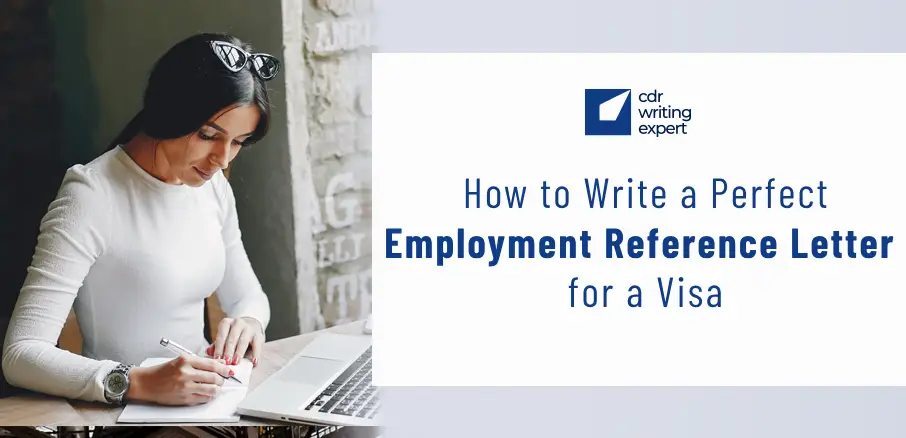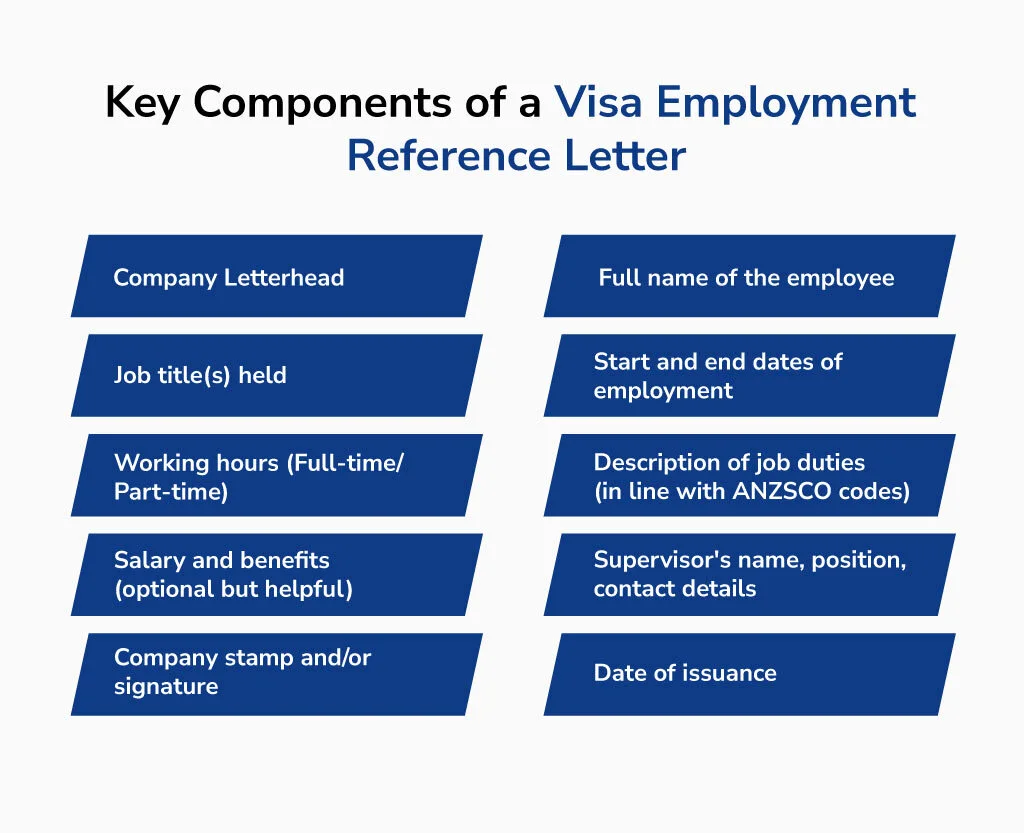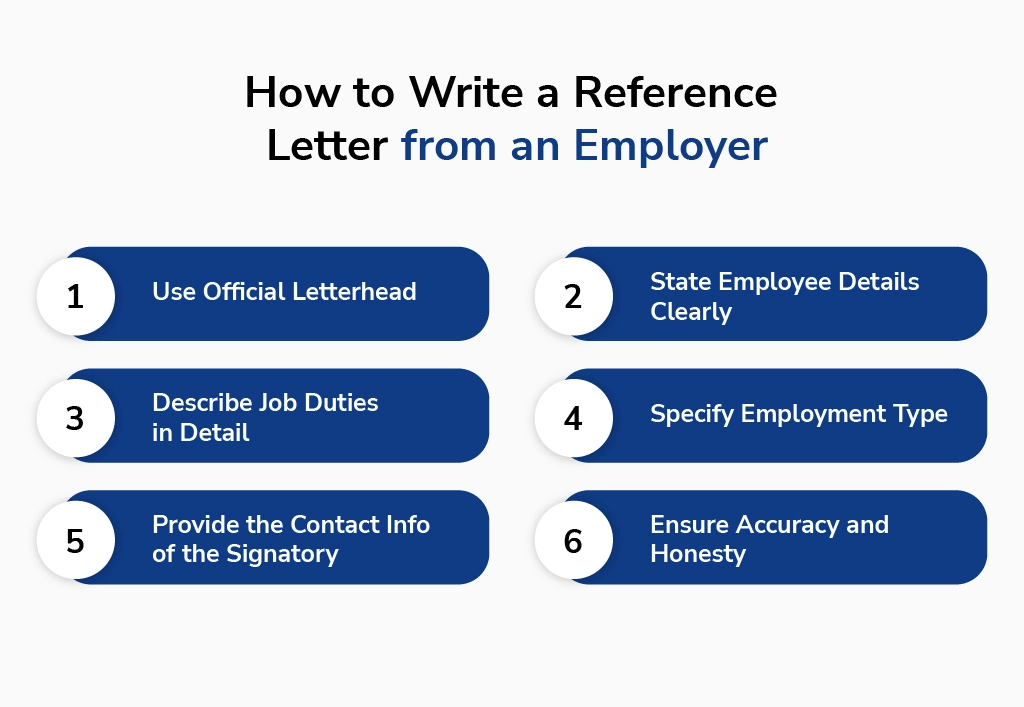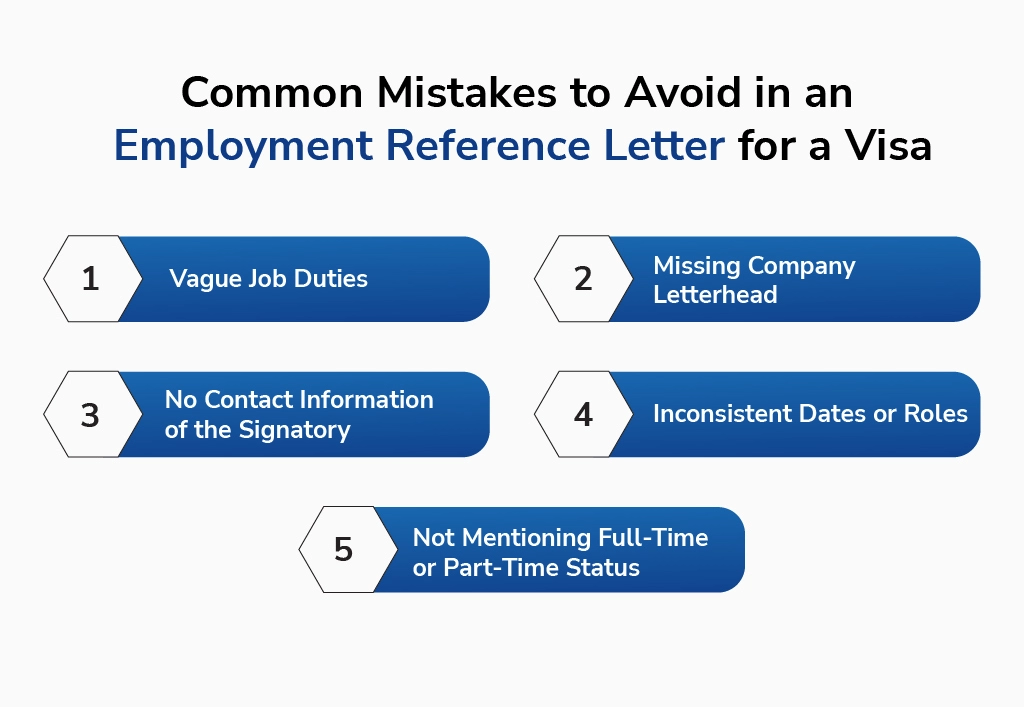
Applying for a visa, whether it’s for work, migration, or tourism, often requires a strong and well-drafted employment reference letter. This document plays a critical role in proving your work history, supporting skill assessment applications, and validating claims made in your resume or visa application.
In this blog, you’ll get everything you need to know to create a perfect employment reference letter for a visa, especially focusing on Australian immigration requirements.
What Is an Employment Reference Letter?
An employment reference letter (also called an employer letter, work reference letter, or proof of employment letter) is an official document written by a current or former employer. It confirms details like your position, duration of employment, duties, salary, and performance.
This letter is a critical component when applying for a:
- Skilled migration visa
- Employer-sponsored visa
- Temporary visa (like a tourist visa with proof of return-to-work guarantee)
- Partner or dependent visa (to support the sponsor’s employment)
For individuals seeking skilled migration to Australia, this guide specifically addresses employment reference letters. While reference letters can have various uses (educational, personal, etc.), we will concentrate on what you need from a former employer or supervisor for your Australian immigration application.
To help you secure a strong letter, we’ll look at examples and answer common questions about length, format, and the crucial information required for Australian immigration.
When Is It Used?
- Employment reference letter for Australian immigration (Skilled Migration)
- Employment reference letter for VETASSESS skill assessment
- Employment reference letter for Engineers Australia
- Employment letter for tourist visa Australia (to prove the temporary nature of the visit)
- Employment letter for Australia visa application in general
What Is A Good Employment Reference Letter?
A strong employment reference comes from someone who worked directly with the employee and can illustrate their skills with concrete examples. This well-organised and written letter should emphasise the employee’s positive attributes and accomplishments. Such a letter can significantly improve an applicant’s job prospects or program admissions.
For instance, a good reference might start by outlining how the writer knows the employee and for how long. Following this, it should include specific instances of the employee’s performance, like their punctuality, teamwork skills, or problem-solving abilities.
Key Components of a Visa Employment Reference Letter
Wondering what an employment letter includes? Here are the essential details:

1. Company Letterhead
- The letter must be printed on the official company letterhead.
- It should include the company’s logo, name, address, contact number, email, and website (if any).
- A letter without a letterhead may not be accepted for skill assessments or visa applications.
2. Full name of the employee
- Mention the applicant’s full legal name as per passport or official documents.
- Make sure the name matches the one used in your visa or skill assessment application.
3. Job title(s) held
- Specify all job titles held during the period of employment.
- If the employee had promotions or role changes, mention each role separately with corresponding dates.
- Example: “Software Developer (Jan 2018 – June 2020), Senior Software Developer (July 2020 – Dec 2022).”
4. Start and end dates of employment
- Include the exact start and end dates (DD/MM/YYYY format is preferred).
- If the employment is ongoing, write “to present” or “currently employed.”
5. Working hours (Full-time/Part-time)
- State whether the employee worked full-time (typically 38+ hours/week) or part-time.
- Mention the exact number of hours per week (e.g., 40 hours/week) to validate full-time experience for PR or assessment purposes.
6. Description of job duties (in line with ANZSCO codes)
- This is one of the most critical components of the letter.
- The listed duties must closely match the ANZSCO code responsibilities of the nominated occupation.
- Use bullet points and action verbs like “developed,” “managed,” “analysed,” etc.
- Ideally, at least 65% of the tasks should align with the nominated occupation for VETASSESS or Engineers Australia assessments.
7. Salary and benefits (optional but helpful)
- Include the annual gross salary, and mention any benefits like bonuses, health insurance, etc.
- It adds credibility and context to your role and seniority level.
8. Supervisor’s name, position, contact details
- Mention the name, designation, official email address, and phone number of the person who signed the letter.
- This allows the immigration department or assessing authority to verify your employment if needed.
9. Company stamp and/or signature
- The letter should be signed by an authorised signatory, usually an HR manager, direct supervisor, or company director.
- It should include a company stamp or seal for official authenticity.
10. Date of issuance
- Add the date on which the letter was issued.
- Immigration authorities prefer recently dated letters (within 6–12 months of your application submission).
How to Write a Reference Letter from an Employer

a. Use Official Letterhead
The letter must be printed on the company’s official letterhead, with the logo, company name, address, and contact details.
b. State Employee Details Clearly
Include the employee’s full name, job title(s), and exact dates of employment (start and end).
c. Describe Job Duties in Detail
List the main tasks and responsibilities in line with the relevant ANZSCO occupation code (for skilled migration).
d. Specify Employment Type
Mention whether the employee was full-time, part-time, or contractual, and include weekly working hours.
e. Provide the Contact Info of the Signatory
Add the name, designation, email, and phone number of the person signing the letter for verification.
f. Ensure Accuracy and Honesty
Keep the content truthful, consistent with your CV, and avoid exaggeration or vague wording.
Employment Reference Letter for Australian Immigration Sample
Here’s a practical employment reference letter for Australian immigration sample that follows the VETASSESS and Engineers Australia requirements.
Sample 1
[On Company Letterhead]
To Whom It May Concern,
This letter is to confirm that Mr. Rajeev Sharma was employed with XYZ Tech Pvt Ltd from March 1, 2018, to June 30, 2022. He held the position of “Software Engineer” and worked on a full-time basis, 40 hours per week.
His main duties included:
– Analysing user requirements and system specifications
– Designing and developing software systems using Java and SQL
– Conducting unit testing and integration testing
– Collaborating with cross-functional teams
– Writing technical documentation
His gross annual salary was AUD 85,000.
Should you require further verification, please contact us at +61 2 1234 5678 or email hr@xyztech.com.au.
Sincerely,
[Signature]
Lisa Andrews
HR Manager
XYZ Tech Pvt Ltd
This format works well as a sample employment reference letter for Australia and meets the standard required for a visa application employment reference letter for Australian immigration.
Sample 2
[Company Letterhead]
Date: 18th March 2025
To Whom It May Concern,
This letter serves as a reference for [insert name], who has been employed as the [Designation] at [Name of organisation, address] from [start date] to [end date]. During this period, [insert name] worked on a full-time basis, committing [number of hours] hours per week, with a monthly pay rate of [pay rate].
As a [Designation], Insert name was responsible for the following key duties and responsibilities:
- Oversaw the management and sourcing of a wide range of hair and grooming products, ensuring that the inventory met the salon’s operational needs.
- Creating and executing sourcing strategies to source premium products for salons at reasonable prices, ensuring high standards of service and product availability.
- Establishing pricing structures for salon services and products that maintain profitability while providing value to customers.
- Established and maintained high-quality service protocols for Afro & straight hair treatments, men’s & kids’ grooming, women’s hair services, trims/line-ups, and colouring or bleaching.
- Planned and executed promotional campaigns, including those via social media, local events, and strategic partnerships to enhance brand awareness.
- Actively promoting salon offerings, upselling services, and recommending hair care products tailored to customers’ individual needs.
- Guiding customers on product usage, styling tips, and aftercare to enhance customer satisfaction and loyalty.
- Maintaining accurate records of stock levels, reordering supplies to avoid shortages or overstocking, and ensuring smooth operational flow.
- Hiring, training, and supervising salon staff, ensuring they meet the salon’s standards for performance and customer service.
- Enforce salon policies related to hygiene, customer service standards, and workplace conduct to ensure a positive and professional environment.
Insert Name’s dedication to the salon’s growth and smooth operations has been invaluable. His professionalism, leadership, and organisational skills have significantly contributed to the success of [Company name].
For any additional information, please feel free to contact us.
Sincerely,
[Your Name]
[Your Position]
[Company name]
[Address]
Sample Employment Letter for Tourist Visa Australia
Even if you’re applying for a tourist visa, an employment letter can help convince authorities of your intent to return.
Sample:
To Whom It May Concern,
This is to certify that Ms. Ayesha Khan has been employed with ABC Marketing Solutions since January 10, 2020, as a Marketing Executive.
She is currently on an approved leave of absence from June 10, 2025, to July 5, 2025, to travel to Australia for tourism purposes. She will resume her duties on July 6, 2025.
We confirm her annual salary is AUD 60,000, and her employment is ongoing.
Sincerely,
[Signature]
Mark Peters
HR Manager
ABC Marketing Solutions
This acts as a strong employment letter for the tourist visa to Australia.
Employment Reference Letter Template Australia
Here’s a reusable employment reference letter template for Australia that you can adjust for different job roles.
Template:
[Company Letterhead]
Date: [Insert Date]
To Whom It May Concern,
This is to confirm that [Employee Name] worked with [Company Name] from [Start Date] to [End Date] in the capacity of [Job Title].
The employment was [Full-Time/Part-Time], and the average number of hours worked per week was [Number].
Primary responsibilities included:
– [Duty 1]
– [Duty 2]
– [Duty 3]
– [Duty 4]
This position was paid at a rate of [Salary], and [he/she/they] reported to [Manager Name & Position].
Please feel free to contact us for any further verification.
Sincerely,
[Signature]
[Name]
[Designation]
[Company Contact Details]
Save and send as an employment reference letter for Australia in PDF format to avoid formatting issues.
Common Mistakes to Avoid in an Employment Reference Letter for a Visa
When drafting or submitting an employment reference letter for a visa or Australian immigration, many applicants unknowingly include errors that may lead to delays, rejections, or skill assessment failure. Below is a breakdown of the most common mistakes and why they matter.

❌ 1. Vague Job Duties
What this means:
Using generic phrases like “responsible for software development” or “involved in management tasks” without a detailed explanation.
Why it’s a problem:
Visa officers and skill assessment bodies like VETASSESS or Engineers Australia assess your eligibility based on your actual tasks and how well they match the ANZSCO job description. Vague duties make it hard to determine your skill level or occupation relevance.
How to fix it:
Be specific. Use clear action verbs (e.g., developed, implemented, managed, analysed) and align at least 65% of your duties with your ANZSCO role.
❌ 2. Missing Company Letterhead
What this means:
Submitting a letter without the official company letterhead or using a plain Word document.
Why it’s a problem:
Letters without a letterhead are viewed as unofficial and unverified, and may be rejected outright by immigration or assessing authorities.
How to fix it:
Ensure the letter is printed on the company’s official stationery, which includes the logo, address, phone number, email, and possibly website.
❌ 3. No Contact Information of the Signatory
What this means:
The letter is signed, but there’s no name, designation, email, or phone number of the person verifying your employment.
Why it’s a problem:
Assessors may need to verify the authenticity of your employment. Without contact details, the letter’s credibility is questioned.
How to fix it:
Always include the full name, job title, work email, and official contact number of the person signing your letter. Preferably, this should be your supervisor, HR, or company director.
❌ 4. Inconsistent Dates or Roles
What this means:
The employment dates in the letter don’t match your resume, payslips, or previous applications. Or you list different job titles for the same period.
Why it’s a problem:
Inconsistencies are red flags for misrepresentation or fraudulent claims. This can lead to application refusal or a ban from applying for a period.
How to fix it:
Ensure all your documents (resumes, reference letters, payslips, tax docs) are consistent in terms of job titles and timelines. If your role changed, list each role separately with accurate start and end dates.
❌ 5. Not Mentioning Full-Time or Part-Time Status
What this means:
The letter doesn’t mention how many hours you worked per week or whether it was full-time/part-time.
Why it’s a problem:
Australian immigration and skill assessment bodies have strict criteria regarding work experience points. They usually only accept full-time work (at least 20–38 hours/week).
How to fix it:
Clearly state the number of hours worked per week and mention the work type (e.g., “Full-time, 40 hours per week”). For part-time, mention if the total hours add up to a full-time equivalent.
Conclusion
A well-drafted employment reference letter for a visa is more than just a formality, but it’s often the deciding factor in whether your visa is approved or not.
Whether you’re applying for skilled migration, VETASSESS assessment, or even a tourist visa, ensuring your letter is detailed, truthful, and aligned with immigration requirements is crucial.
If you’re unsure, consider professional help or consult migration experts who specialise in preparing employment reference letters for Australian immigration.
Frequently Asked Questions (FAQS)
a. What do you write in an employment reference letter?
You should include: name, role, duration, job duties, hours worked, and supervisor contact.
b. What is a proof of employment letter?
It’s a formal letter issued by an employer confirming employment status, job title, and dates of service used for various purposes, including visa applications.
c. How to ask for a proof of employment letter?
Ask politely via email or the HR portal. Mention the purpose (visa), deadline, and sample format if needed.
d. How to send a reference letter to an employer or authority?
Ideally, via PDF on company letterhead, signed and stamped, and included as an attachment in your application submission.
e. Can I submit an unsigned letter?
No. Immigration authorities require a signed and verifiable document.

